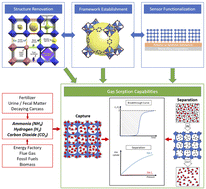Historical and contemporary perspectives on metal–organic frameworks for gas sensing applications: a review
Abstract
Metal–organic frameworks (MOFs) are a class of crystalline compounds with porous characteristics and high specific surface area, featuring coordinated metal nodes and ligands formed through covalent and ionic bonds. In this review, we discuss selected research on MOF-based applications, specifically in the area of gas-sensing applications for ammonia (NH3), hydrogen (H2), and carbon dioxide (CO2). MOFs are highlighted both in the context of increasing the sensitivity and specificity of sensing towards such specific gases and defining essential design and functionalization parameters of the framework to allow its use over multiple cycles, while maintaining high efficiency and sustainability. Lastly, the outlook section of this review focuses on the next steps in the formation of MOFs and how their structure–function–performance relationships can help establish framework usability upon implementation, while under user control.

- This article is part of the themed collection: RSC Sustainability Recent Review Articles


 Please wait while we load your content...
Please wait while we load your content...